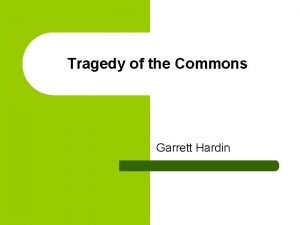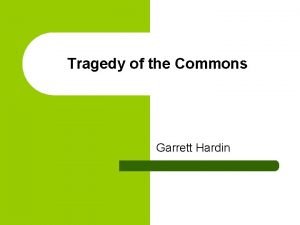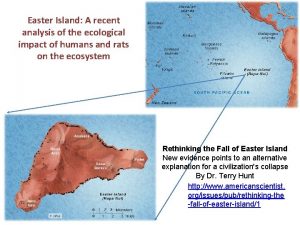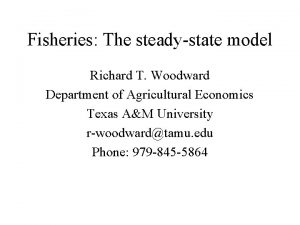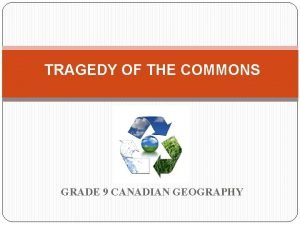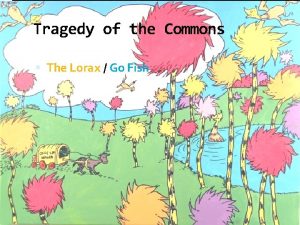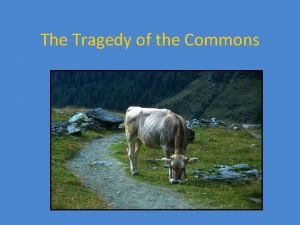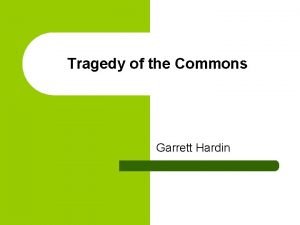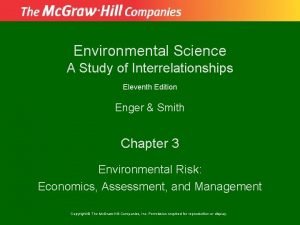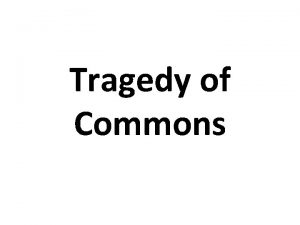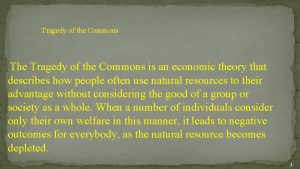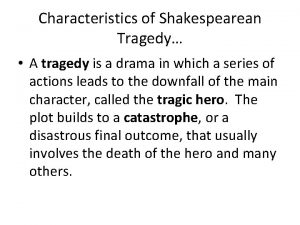Tragedy of the Commons Tragedy of the Commons





















- Slides: 21

Tragedy of the Commons �Tragedy of the Commons refers to a famous essay written by Garrett Hardin �The “Tragedy of the Commons” is one of the most important topics in environmental science. �Many resources (ex. Clean air, biodiversity, fresh water) are available to many people. �When resources are shared and limited (though potentially renewable), they are often exploited.

Tragedy of the Commons �Resources are exploited because the benefit to one person of using more of the resource outweighs the cost to that individual of the resource’s overuse. �Each person looks out only for his own interests, and succumbs to the logic that, “If I don’t use the resource, then someone else will. I might as well get the benefit”

Tragedy of the Commons �Learning to overcome our natural tendency to overuse common resources is one of the most significant challenges we face in learning to improve the environment.

Tragedy of the Commons �Questions: � 1. ) What types of things/places could be considered “commons”? � 2. ) Do you think access to common areas such as national parks (owned collectively by all citizens) should be open to everyone, all of the time? Would your opinion change if the influence of the “crowd” actually diminished the parks natural resources or aesthetic value?

Tragedy of the Commons � 3. ) What are some things that can be done to prevent the “tragedy of the commons” ? � 4. ) How does someone throwing a cigarette butt out of the car window demonstrate the tragedy of the commons in terms of pollution?

History of Environmental Science �Environmental issues have surfaced throughout human history! �The evidence for this is found in manuscripts, publications and historical archives, but it is often found under labels like public health, conservation, preservation of nature, smoke abatement, municipal housekeeping, occupational disease, air pollution and water pollution. Not necessarily under the more modern term “environmental”

�Long before Silent Spring was written or Greenpeace activists defied whalers harpoons, many thousands of “green crusaders” tried to stop pollution, promote public health and preserve wilderness

Important Events in Environmental Science… � 1957 -Discovery of carbon dioxide accumulation in the atmosphere: Roger Revelle and Charles Keeling of Scripps Institution of Oceanography began documenting the global rise of Carbon dioxide. � 1962 -Publication of Silent Spring: Rachel Carson wrote the book that called for an end to indiscriminate pesticide use and a change in the way we view nature. � 1974 -Discovery of atmospheric ozone depleting chemicals: F. Sherwood Rowland Mario J. Molina describe the way refrigerants (CFC’s) break up ozone.

Important Events in Environmental Science… � 1798: publication of the book, An Essay on the Principle of population, by Thomas Malthus. Which predicted the fate of mankind if population continues to increase. The book was very influential in its time and was cited by both Charles Darwin and Alfred Russell Wallace in developing theory of evolution.

Man-made disasters… � 2011 -Fukushima Daiichi: Three nuclear reactors melt down on Japan’s east coast. The meltdowns were triggered by an earthquake and tsunami. Health impacts from the Fukushima disaster may ultimately turn out to be more serious than Chernobyl. � 2010 -Deepwater Horizon oil spill, Gulf of Mexico: An explosion kills 11 people and results in an oil spill of millions of gallons that were driven by wind and tides into fragile coastal ecosystems in Louisiana and Mississippi.

Man-made disasters… � 1989 -Exxon Valdez oil spill, Prince William Sound, Alaska: Exxon tanker ran aground spilling 11 million gallons of oil into a fragile ecosystem.

Man made disasters… � 1986 -Chernobyl nuclear disaster, Ukraine: A safety experiment gone wrong, the reactor exploded killing 50 people immediately, 4000 over the short term and exposing over a half a million people to high levels of radiation.

Man-made disasters… � 1984 -Bhopal disaster, India: Union Carbide Co. fertilizer plant leaks methyl icocyanide in Indian town of Bhopal. 2000 dead, another 8000 die of chronic effects. It is estimated that another 50, 000 people remained partially or totally disabled.

Man-made disasters…. � 1924 -Leaded Gasoline: In 1924 the public first learns of the insanity and death at refineries owned by Standard Oil and Du. Pont making leaded gasoline additive. Due to the power of the oil and automotive industries it takes until 1986 to ban leaded gasoline in the US and until 2000 to ban it in Europe and the rest of the world.

Environmental Science Hall of Fame

Hall of Fame…. �John Snow: (1813 -1858) Physician who realized that cholera is transmitted by water. He was known as the physician who “broke” the Broad street pump handle because he was tired of waiting for reform. He convinced the local board of health to shut the pump down and called for sanitary reform of the water systems.

Hall of Fame… �Alice Hamilton (1869 -1970): the founder of occupational medicine in the US and the first woman on the faculty of Harvard Medical School. She had a leading role in two major environmental controversies of the 1920’s involving leaded gasoline and radium dial painters. (known as the “radium girls”)

Hall of fame… � John Muir-(1838 -1913) America’s most influential conservationist, Muir published 300 articles and 10 major books that recounted his travels and explained his naturalist philosophy. In 1892 he founded the Sierra Club to , as he said, “do something for wildness and make the mountains glad”

Hall of fame… �George Washington Carver: (1865 -1943) researched industrial applications from farm products-significant in the environmental movement because his ideas pointed the way towards development of biologically compatible paths to sustainable development.

Hall of fame… �Rachel Carson-(1907 -1964) Author of Silent Spring. She was a writer, scientist and ecologist who called into question the broad use of pesticides, particularly DDT. �“The more clearly we can focus our attention on the wonders and realities of the universe about us, the less taste we shall have for destruction. ” � -Rachel Carson

Hall of fame… �Gifford Pinchot-(1865 -1946) Served as the first head of the US Forest Service. One of Americas leading conservationists and environmental conservation at the turn of the twentieth century.
 The tragedy of the commons garrett hardin
The tragedy of the commons garrett hardin Travedy of the commons
Travedy of the commons Easter island tragedy of the commons
Easter island tragedy of the commons Tragedy of the commons
Tragedy of the commons Tragedy of the commons easter island
Tragedy of the commons easter island Tragedy of the commons
Tragedy of the commons Tragedy of the commons definition apes
Tragedy of the commons definition apes Maximum sustainable yield
Maximum sustainable yield Tragedy ofthe commons examples
Tragedy ofthe commons examples Three commons in the lorax
Three commons in the lorax Example of tragedy of the commons
Example of tragedy of the commons Goods that are excludable include both
Goods that are excludable include both Externality examples
Externality examples Law of commons
Law of commons Tragedy of the commons
Tragedy of the commons Tragedy of commons environmental science
Tragedy of commons environmental science Shakespeare comedy vs tragedy
Shakespeare comedy vs tragedy Characteristics of tragedies
Characteristics of tragedies Greek theatre history
Greek theatre history điện thế nghỉ
điện thế nghỉ Tia chieu sa te
Tia chieu sa te Một số thể thơ truyền thống
Một số thể thơ truyền thống
